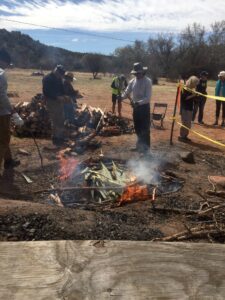Agaves have been an important plant for desert dwellers for thousands of years. In addition to being a dependable and nutritious food source, agaves are an excellent source of fiber for clothes, sandals, rope, and building materials. Agaves were a staple food source for many Native Americans. The importance of agaves to pre-historic and historic Native Americans can be summed up by: “Agaves were to inhabitants of the Southwest, what bison were to the Plains people.”
While agaves are a wonderful food source, they are toxic to humans in their raw form. Once harvested, the hearts and leaves need to be roasted for 2-3 days. Native Americans constructed stone-lined pits in the ground, in which they built large fires. After the pits’ coals and stones were hot for several hours, the prepared agave hearts and leaves were placed in the pit and then covered with soil and other vegetation, effectively steaming the agaves in the ground. Once cooked, agaves would be pounded into sheets and dried for later consumption. A roasted agave heart is quite sweet and tasty, even to modern tastes. The Yavapai have been known to provide it to their children as treats. A roasted agave has a shelf-life of several years; it therefore traveled and traded well, and was an ideal food source in lean times.
Globally, there are over 250 species of agaves with about 20 in Arizona. In the Verde Valley, the most common native agave is the Agave Parryi, which resembles a giant artichoke. Agaves are sometimes labeled “Century Plants”, because they are mistakenly thought to take up to 100 years to mature. Maturity is reached when an agave puts up a flowering stock, but the Agave Parryi achieve this in about 8 to 25 years, depending on soil conditions, light, and water. An agave has matured and ready for harvesting when it is about to put up its flowering stalk. This is when the heart is the sweetest and most palatable for human consumption.
Through chromosome analysis of agave flowers, botanists have determined that, in addition to harvesting wild agaves, ancient Native Americans cultivated agaves for sweetness, tenderness and time to maturity. To date, the botanists at the Desert Botanical Gardens in Phoenix have identified eight species of agave “domesticates” in Arizona with four of those in the Verde Valley.
Given modern botany research, it is believed that some domesticates may have originated in Mexico and were brought up to Arizona by Pre-Columbian Indigenous peoples. Unlike their wild agave Parryi cousins, domesticate agaves are scarce and are deemed a “Sensitive Species.” Because some domesticate agaves brought into Arizona originated in a different environment and climate, their seeds are not viable, so they reproduce asexually. This asexual reproduction via rhizomes has kept them from hybridizing with other wild agaves, and they are thus DNA clones of their predecessors.
Wendy Hodgson, a renowned researcher of agaves at the Desert Botanical Gardens, calls these domesticate agaves “living artifacts” as they are unchanged from what they were when originally introduced to Arizona hundreds of years ago. Through selection and cultivation, ancient peoples created agave species that are sweeter, less fibrous, and mature faster than their wild relatives. For hundreds of years, the Hopi people have recognized the importance of agaves, and one of their four main religious groups is called the Kwan (Agave) Society. Like corn, agaves are of cultural significance.
Distinguishing a domesticate agave from a wild species in the field can be challenging. Wendy has been teaching volunteers in the Friends of Forest how to identify domesticates in the field for ongoing research by the Coconino National Forest and Desert Botanical Gardens.
Want more information about volunteer opportunities with the Friends of the Forest? Visit www.friendsoftheforestsedona.org.
Serving Sedona, written this week by Scott Newth, Friends of the Forest, appears Wednesday in the Sedona Red Rock News..
